Bowers & Wilkins PI5 vs. Bowers & Wilkins PI7: Which noise-cancelling wireless earbuds should you buy?
Our Bowers & Wilkins PI5 vs. Bowers & Wilkins PI7 comparison details which B&W wireless ANC earbuds are the better investment.

This Bowers & Wilkins PI5 vs. Bowers & Wilkins PI7 face-off breaks down the veteran audio brand’s two newest wireless earbuds, helping you decide which pair to buy based on overall performance and value.
The Bowers & Wilkins PI7 serves as the company’s flagship model and the in-ear equivalent to one of the market’s best noise-cancelling headphones, the PX7. High-quality sound combined with adaptive active noise cancellation (ANC) and a striking design make this pair of buds one of the finest that money can buy. The PI7 also has a special audio trick that you won’t find on any other wireless earbuds, which you’ll learn more about further in our analysis.
- The best wireless earbuds you can buy
- Make a saving with the best cheap wireless earbuds
- We've tested the best outdoor speakers
Launched simultaneously, the Bowers & Wilkins PI5 boasts a noticeably different spec sheet. However, it retains similar features and the same appearance as its costly sibling, and at a lower price point. Battery life is longer, while noise cancellation and sound are top notch. There are many reasons why we consider it one of the best noise-cancelling earbuds.
These are two premium noise-cancellers that offer different, satisfying listening experiences. Which is the better splurge? Keep reading our full Bowers & Wilkins PI5 vs. PI7 breakdown to find out.
Bowers & Wilkins PI5 vs. Bowers & Wilkins PI7: Specs compared
| Header Cell - Column 0 | Bowers & Wilkins PI5 | Bowers & Wilkins PI7 |
|---|---|---|
| Price | $249 | $399 |
| Wireless Charging Case | Yes, included | Yes, included |
| Chip | Qualcomm QCC5126 | Qualcomm QCC5126 |
| Battery Life (Rated) | 4.5 hours (ANC on), 24.5 hours (with charging case) | 4 hours (ANC on), 20 hours (with charging case) |
| Water Resistance | IP54 | IP54 |
| Case Size | 2.3 x 1.1 x 2.2 inches | 2.3 x 1.1 x 2.2 inches |
| Case Weight | 1.6 ounces | 2.1 ounces |
| Special features | Active noise cancellation, two-level ambient listening mode, aptX Adaptive support, Soundscapes | Adaptive active noise cancellation, adjustable ambient listening mode, aptX Adaptive support, Soundscapes, wireless adapter functionality |
Bowers & Wilkins PI5 vs. Bowers & Wilkins PI7: Price
Both sets of buds are expensive, but the more reasonably attainable of the two is the PI5 at $249: the same as the AirPods Pro. Unless you’re looking for buds that support all of the latest codecs and provide a unique secondary way of hearing music wirelessly, you’ll find this version to be just as gratifying as its pricier counterpart. Not to mention you’ll save $150 in the process.
At $399, the PI7 is one of the most expensive true wireless options out there. Of course, the high MSRP grants users more perks such as full aptX Bluetooth support and retransmission via charging case. Add slightly better sound and noise cancellation into the equation and it’s clear why these buds don’t come cheap.
Be sure to bookmark our best headphones deals page to stay up on the latest sales.
Winner: Bowers & Wilkins PI5
Bowers & Wilkins PI5 vs. Bowers & Wilkins PI7: Design
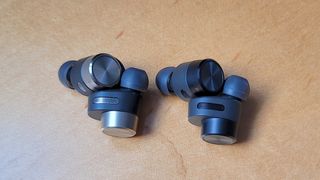
Both the PI7 and PI5 are stunners, with broadly the same striking appearance and superior build quality. The protruding cylinder is a distinctive detail that also acts as a touch panel. An IP54 rating protects these two products from dirt and moisture damage (e.g., light splashes, rain, sweat). B&W’s color options are stylish, but we love the PI7’s two-tone look a little more.
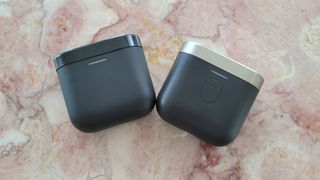
The charging cases look identical, sans the button on the front of the PI7 case, which the company says will take on a future function via firmware update. They each match the aesthetic sleekness of the earbuds and come in the same size, granted the PI7’s case is slightly heavier, but not too heavy to carry on the go. The soft matte finish is a nice touch, plus the buds are displayed handsomely when docked in their respective charging slots. A Bluetooth button is located on the inside as well for manually pairing.
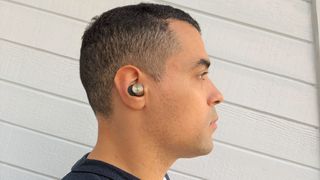
As for functionality, the PI7 case can also double as a wireless adapter to stream music in aptX when connected to an analog audio output. The PI5 case doesn’t.

Comfort and fit are similar too. Neither model will weigh down your ears, though the duration in which you choose to wear the PI7 or PI5 might be short based on your pain threshold. The elongated sound port does apply unwanted pressure to the front of the ear. At least the port nestles well on the inner ear for proper stabilization, while the silicone tips create a tight seal to keep the buds steady.
Winner: Tie
Bowers & Wilkins PI5 vs. Bowers & Wilkins PI7: Controls

B&W programmed on-ear detection, voice assistance, and a wide array of touch gestures into their newest creations, but the PI7 has the more reliable controls. Operating playback and cycling through listening modes is simple, thanks to accurate input demonstrated by the PI7’s touch sensors. The six mics also make using Google Assistant and Siri a pleasure, picking up every syllable and voice command, while both AI bots respond to inquiries in quick fashion.

The PI5 performs similarly in most areas, specifically voice assistance, which is very impressive considering it’s working with two less mics. Unfortunately, the touch sensors misinterpret multi-tap gestures very often. On-ear detection works half the time as well.
Winner: Bowers & Wilkins PI7
Bowers & Wilkins PI5 vs. Bowers & Wilkins PI7: Sound quality

The PI7 has set a new bar for sound on wireless earbuds. B&W stacked these buds with some serious specs, including 24-bit sound, various aptX codecs (Standard, LL, HD & Adaptive), and Dual Hybrid Drive units with individual amplifiers for each driver. It doesn’t matter if you are listening to music from your personal library or hi-quality streaming services like Tidal, the results are sonically serene. Bass is strong, mids and highs are detailed, and it’s pretty cool to be able to single out imperfections on complex recordings that you wouldn’t hear on other wireless earbuds.
But it’s the charging case that makes the PI7 a one-of-a-kind product, allowing you to stream music in aptX when connected to a compatible analog audio output. That’s right. You can connect the case to anything from an iPod Classic to an airplane jack and still enjoy the same wireless sound. No loss in fidelity.

B&W decided to equip the PI5 with a 9.2mm driver that produces spacious audio and well-balanced range. Lows, mids, and highs sound on point, though the PI7’s midrange is more precise. We do wish that B&W would have given the PI5 full aptX support or audio retransmission.
Winner: Bowers & Wilkins PI7
Bowers & Wilkins PI5 vs. Bowers & Wilkins PI7: Active noise cancellation

The PI7 is powered by adaptive ANC and uses six internal mics to automatically reduce the impact of low-frequency noises, something it does incredibly well. Keep in mind that there is an Auto Mode setting that when enabled adapts to the acoustic environment, but it makes the technology less effective and noises more transparent. You’ll want to keep it turned off and stay in manual ANC mode.
We liked that the PI7 put a muzzle on indoor fracas such as loud family members, household appliances, and the humming noise from a centralized AC unit. Using the feature outside is just as rewarding, especially when walking in drafty conditions. High-frequency noises like baby cries, car horns or whistles can still creep onto the soundscape, but the PI7 minimizes them enough to enjoy music peacefully.

The PI5 won’t match that same performance, but it’s no slouch in the noise neutralization department either. It employs standard ANC and uses four mics to effectively silence the majority of unwanted noises. We found the feature useful at home, in grocery stores, and when riding in an Uber. Wind resistance is just as good as on the PI7. Just don’t expect the buds to put a kibosh on construction tools or sirens.
Ambient Pass-Through is B&W’s version of ambient listening and offers a different experience on each model. The PI7 comes with 16 levels of transparency that can be adjusted via slider, while the PI5 has two settings (Less and More) that are self-explanatory. Yes, sounds are much more distinguishable on the PI7 when adjusted to higher levels, but the PI5 also pipes in a good amount of external sound to gain a better awareness of surroundings.
Another great thing about these two sets of buds is that ANC and Ambient Pass-Through can blend together when enabled simultaneously, something the Bose QuietComfort Earbuds also does to make ambient noises sound more distinguishable and less harsh.
Winner: Bowers & Wilkins PI7
Bowers & Wilkins PI5 vs. Bowers & Wilkins PI7: Special features and apps

Being the more expensive model, it’s ideal that the PI7 has more features, including adaptive noise cancellation, audio retransmission, two more dedicated amps, 24-bit audio resolution, and a dedicated external DSP.
The B&W app is where you’ll go to access most functionality. It’s clean, user friendly, and offers much of the same for both models, though the PI7 is given two extras: Auto Mode and transparency adjustment. You still gain access to toggle controls for both Noise Cancellation and Ambient Pass-Through, as well as on-ear detection.
Soundscapes is the app’s signature feature, and it works well for either set of buds. Six different profiles can be selected, each one masking the ambient noise around you with nature sounds for relaxation and stress relief. It’s nothing new to the category, but this might be the best version out there, as every profile accurately reproduces effects true to their environment.
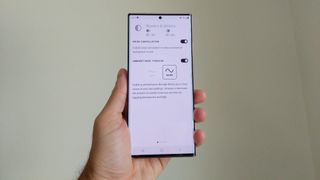
The features list is shorter than what you’ll find on rival apps like Jabra Sound+ and Sony Headphones Connect. It would have been thoughtful if B&W added a voice prompt setting and Standby Timer to place the buds in sleep mode when inactive, which are two features that seem to be reserved for the over-ear PX7 headphones. An EQ and Find My Buds setting would have been welcome additions as well.
Connectivity is equally great, so you’ll be able to pair and re-pair to known devices instantly, no matter the platform. Where B&W dropped the ball is range. For some odd reason, the PI7 and PI5 struggle to keep a connection farther than 15 feet, causing terrible stuttering when taking one step past this distance.
Winner: Bowers & Wilkins PI7
Bowers & Wilkins PI5 vs. Bowers & Wilkins PI7: Call quality

Even with fewer mics, the PI5 is the better calling headset. You’ll still hear noises when speaking in rowdy settings. However, the PI5 make voices somewhat clearer than the PI7. Volume is also higher and wind resistance is stronger, minimizing cutouts and interference in drafty environments. Feedback from clients and friends was mostly positive when using the PI5.
We found the PI7 useful for taking business calls and video chats indoors, but that’s about it. Whenever answering the phone outside, crackling and wind became issues. Volume was very low too, which always makes it difficult to hear others on the opposite end. Neither are the best headphones with a mic for voice and video calls, but despite the price difference, the PI5 is superior here.
Winner: Bowers & Wilkins PI5
Bowers & Wilkins PI5 vs. Bowers & Wilkins PI7: Battery life
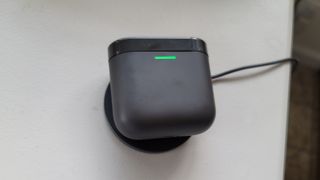
The PI7 is rated super-low at just 4 hours with ANC enabled, whereas the PI5 comes in a smidge higher at 4.5 hours — again with ANC. This is just as underwhelming as the AirPods Pro (4.5 hours) and not even half of what some other competitors manage, such as the Master & Dynamic MW08 (10 hours). Since it runs fewer features and provides 30 minutes extra listening time, this round goes to the PI5.
Their respective wireless charging cases support quick charging and are equally powerful, netting users 2 hours on a 15-minute charge.
Winner: Bowers & Wilkins PI5
Bowers & Wilkins PI5 vs. Bowers & Wilkins PI7: Verdict
The PI7 is tough to overlook based on sound quality alone; it's truly second to none in the area. Support for all aptX codecs is pretty rare too, and the multipurpose charging case gives you another way of enjoying music wirelessly and with minimal loss in fidelity. ANC is also solid, giving the AirPods Pro a run for its money. Bluetooth could be stronger, and playtimes are pretty bad, though at least you have the charging case and quick charging to relieve your low-battery anxiety.
| Header Cell - Column 0 | Bowers & Wilkins PI5 | Bowers & Wilkins PI7 |
|---|---|---|
| Price and value (5) | 4 | 3 |
| Design (15) | 13 | 13 |
| Controls (10) | 6 | 7 |
| Audio quality (20) | 18 | 20 |
| Active noise cancellation(20) | 17 | 18 |
| Special features and apps (15) | 8 | 10 |
| Call quality (5) | 4 | 3 |
| Battery life (10) | 6 | 5 |
| Total score (100) | 76 | 79 |
Just because the PI5 is a scaled down version of the PI7 doesn’t make it any less valuable. Specific features are missing from the spec sheet, but these buds are still capable of pumping out rich and detailed sound. ANC is just as effective. Also, the fact that you’re getting higher battery life, along with better call quality, gives the PI5 extra selling points.
Had it come with some of the PI7’s exclusive audio and software perks, a different winner may have been crowned, but even at a significantly higher price the PI7's extras give it the edge.
- More: Want more audio goodness? Check out the best desktop speakers
Sign up to get the BEST of Tom’s Guide direct to your inbox.
Upgrade your life with a daily dose of the biggest tech news, lifestyle hacks and our curated analysis. Be the first to know about cutting-edge gadgets and the hottest deals.
A lifestyle journalist with an affinity for consumer products, Alex has over a decade of experience and has worked with popular publications such as Complex, Thrillist, Men’s Health, Gear Patrol, AskMen, and Hoop Magazine. He currently focuses on audio, reviewing the most coveted headphones in the market for both Tom’s Guide and Laptop Magazine.

